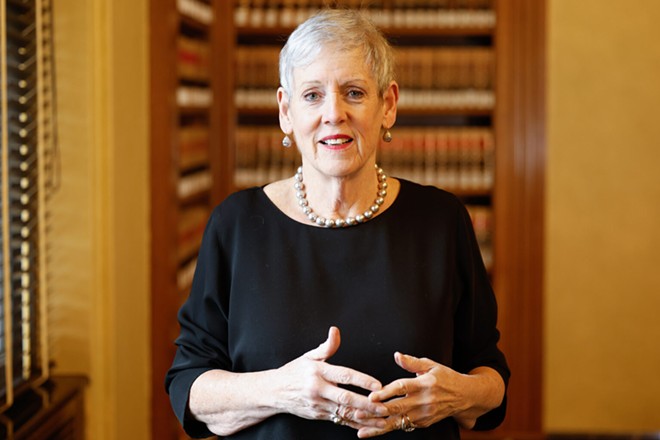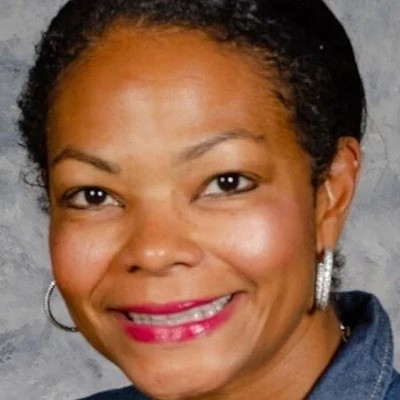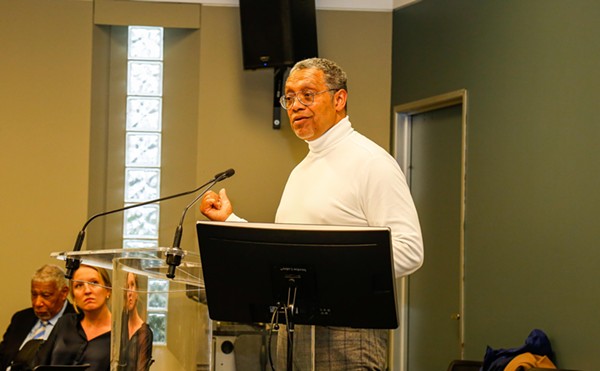
As Ohio Supreme Court Chief Justice Maureen O’Connor takes her leave from the state’s top court position, she takes with her a fierce loyalty to an independent judiciary and fervent belief that she couldn’t have done the job alone.
What she’s boxing up with the trash is any desire for partisanship or politics.
“You don’t take your politics, you don’t take your religion, you don’t take a lot of things into consideration,” O’Connor said. “They don’t color how you do your job and if they do … you don’t deserve to wear the robe.”
As the first woman to serve as head of the state’s highest court and the longest-serving statewide elected woman in Ohio history, what’s driven O’Connor through her career is an unceasing curiosity. That curiosity led her from her beginnings with the Summit County Probate Court in the 1980s, through county judgeships and a stint as the prosecuting attorney, which she took on with pride.
“It was four years of just, wow, talk about a Hellzapoppin’ job that every moment was something new, something interesting, something you had to deal with,” O’Connor said in an interview with the OCJ and WEWS.
She then served as lieutenant governor under Republican Gov. Bob Taft in the late ‘90s, before Sept. 11 changed her trajectory to the first Ohio liaison for the U.S. Department of Homeland Security.
O’Connor joined the Ohio Supreme Court in 2003 and started her tenure as chief justice in 2010. Her time is ending because Ohio’s chief justice can’t run for reelection past the age of 70. O’Connor is 71.
“I’ve had positions that most people would have stayed in and retired in, but sometimes when opportunities present themselves, I’m a curious enough person to say ‘geez, I wonder what that would be like,” she said.
She’s noticed a shift in the concept of retirement since she announced her own plans. The people that know her best aren’t assuming she’s going to rest on her laurels.
“It’s not any kind of expectation that you’re going to be taking things easy and probably sitting on a rocker in Florida,” O’Connor said. “That’s not going to happen.”
In fact, the chief justice has already hinted at her future plans. In a “State of the Judiciary” speech she made at the Ohio Judicial Conference earlier this year, O’Connor made it clear pushing back against partisan gerrymandering is on her radar.
Redistricting
The future goal comes on the heels of bitter battles between the Ohio Supreme Court and the Ohio Redistricting Commission since September of last year, when the first legislative and congressional redistricting maps came out.
“It would have been so easy to do the right thing, and it wasn’t done,” O’Connor said.
After the supreme court found five statehouse maps and two congressional maps unconstitutional, with O’Connor on the side of the majority each time, redistricting is in a state of limbo that’s just as frustrating as the process to get here was.
In rejection after rejection, the supreme court gave the commission “directives,” including the use of independent mapmakers and demands that the process be conducted in the public eye.
“All along, there was absolute resistance to doing that,” O’Connor said.
Several maps were presented without any public interaction, and the maps put together by two independent mapmakers were dismissed by the ORC in favor of maps that had already been rejected by the court.
When the process was brought to a three-judge panel in federal court, the judges gave the commission one more chance to draw a constitutional map, but in O’Connor’s opinion, they also dangled the carrot of a previous map as the last resort.
“My thought on it was: If you hadn’t given them the wink and nod that the third map was going to be used; where’s the incentive for them to have done something by the end of May with a constitutional map?” O’Connor said. “Absolutely none.”
Commission members have pulled a new card after so many tries with the state-level court, filing a request with the U.S. Supreme Court for case review. Chief Justice O’Connor isn’t confident in the commission’s chances with the higher court, but she also doesn’t see the court battles as the fatal flaw in the state’s redistricting process.
Why, then, didn’t the state supreme court hold the Ohio Redistricting Commission in contempt, especially with O’Connor herself taking the lead on a motion to compel the members to explain the violations of court orders?
The ORC asked for more time, a few commission members (Senate President Matt Huffman and House Speaker Bob Cupp) replaced themselves to move on to what they said were other legislative duties, yet another unconstitutional map emerged and ORC leaders started their path toward the U.S. Supreme Court.
In the end, O’Connor didn’t see the legal maneuver as a solution that would teach any lessons. Holding an entire group of elected officials in contempt would have been “more harmful to the image of the institutions in this state” in a situation where “there was enough harm being done as is.”
“I do believe that given what the reaction of the legislature would have been, and the fact that one of these (commission) members was governor, that it could very well have led to what I would consider a constitutional crisis, and I did not want that muddying the waters,” she said. “I did not want them to, in some way, portray the victim.”
Integrity over party
During the course of the redistricting maelstrom, O’Connor was called a lot of things, including traitorous to her party. One GOP (and ORC) member, Secretary of State Frank LaRose, suggested he wouldn’t be opposed to her impeachment from the bench.
The chief justice took these comments with a chuckle, minimizing them to “political drama.”
“Those are partisan statewide officeholders and they have a base that they have to appeal to,” O’Connor said.
She remained unmoved when fellow members of her court criticized her as part of the majority for rejection redistricting maps, and her successor to the chief justice chair, Justice Sharon Kennedy, accused her of judicial overreach in asking commission members to appear for a contempt hearing.
“They’re entitled to their own opinion,” she said.
O’Connor insists these issues have never impacted her ability to do any of the jobs she’s held, particularly within the judicial system, because she’s “never been that kind of Republican.”
“I’ve never let being a Republican affect my role as a judge,” she said. “If I would do that, I’d be unfit for office.”
What she protects over political party and everything else is the independence of the judiciary, and the idea that the three branches of government are meant to be inherently coequal. That’s why she’s never liked headlines, even positive ones, that pit her as a foil to fellow GOP members.
She made national headlines when she spoke out against the Ohio Republican Party’s browbeating of a Democratic Franklin County Common Pleas Judge’s ruling in a 2020 ballot drop-box case, wherein he ruled in favor of Democrats.
The ORP accused the judge of collusion, saying he “parroted his party’s talking points in his ruling.”
O’Connor condemned the GOP statement and called it a “blatant and unfounded attack.”
Looking back on that time, she still doesn’t see herself as a Republican standing up to fellow Republicans.
“Here is a chief justice calling out politicians who are threatening the integrity of a judge and the independence of the judiciary, that’s what that dynamic was,” she said.
As the U.S. Supreme Court considers Moore v. Harper — a case that interrogates the power that state legislatures should have in election-related matters — she hopes the nation’s constitutional checks and balances won’t be flipped on their head with the ruling.
“I see it as a threat to the constitutional authority of the judiciary,” O’Connor said. “I think it will undermine democracy in this country if legislators are able to gerrymander the districts, both congressional and within the states.”
She “absolutely” believes that members of the Ohio Legislature support the independent legislature theory, a centuries-old theory that the state legislatures should be the only governmental body in authority with respect to elections, which is at the center of the Moore case. They theory has repeatedly been rejected by previous courts.
It also isn’t surprising to the chief justice that a movement has been started by the GOP supermajority in Ohio to change the rules as to how a constitutional amendment makes it onto voters’ ballots.
“I don’t think it’s a coincidence that this is being proffered by the legislature when you have reaction to Dobbs (the U.S. Supreme Court case that overturned Roe v. Wade) and a woman’s right to choose in the state of Ohio,” O’Connor said. “When you have an outcry by the public against gerrymandering and the way the constitution is now written (on redistricting).”
Satisfaction
After building a career of leadership within the state, O’Connor acknowledges she’s never been able to succeed without a strong team behind her.
“I’ve never done anything on my own, without a staff that was well-chosen and have served me and the offices that I’ve had very well,” she said.
With eyes toward her life outside of the judiciary, she said her time in the public eye hasn’t changed her as a person, and she doesn’t think people see her any differently than she sees herself.
“I think the people will characterize me as honest and direct, if anything,” O’Connor said. “And I think that I have a certain level of satisfaction for what I’ve accomplished in every position I’ve had and that is certainly true as chief justice.”
She hopes that honesty spreads to her fellow public officials, especially in future elections, where she says officials need to do everything they can to inform the public, rather than leaving the voters to dig deep into the issues to find the true motives.
“Reality requires you to be honest with the electorate,” she said.
Originally published by the Ohio Capital Journal. Republished here with permission.










